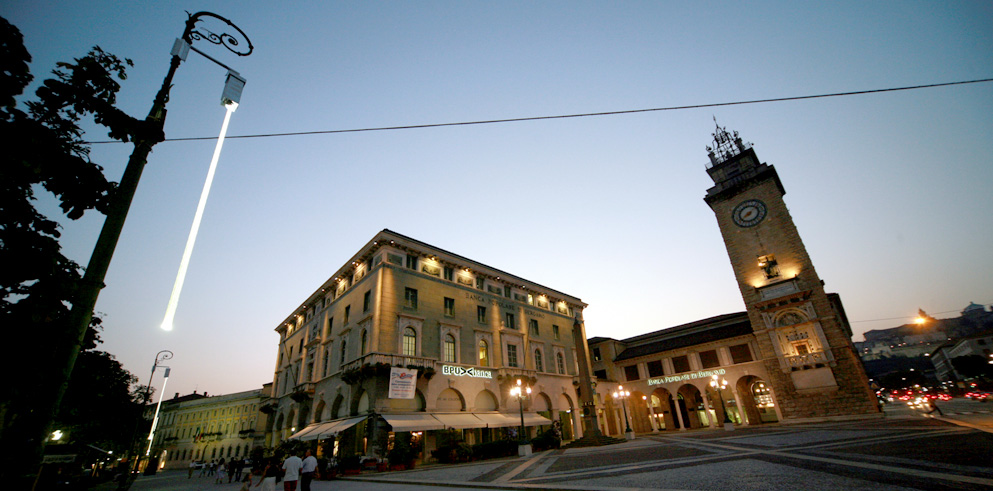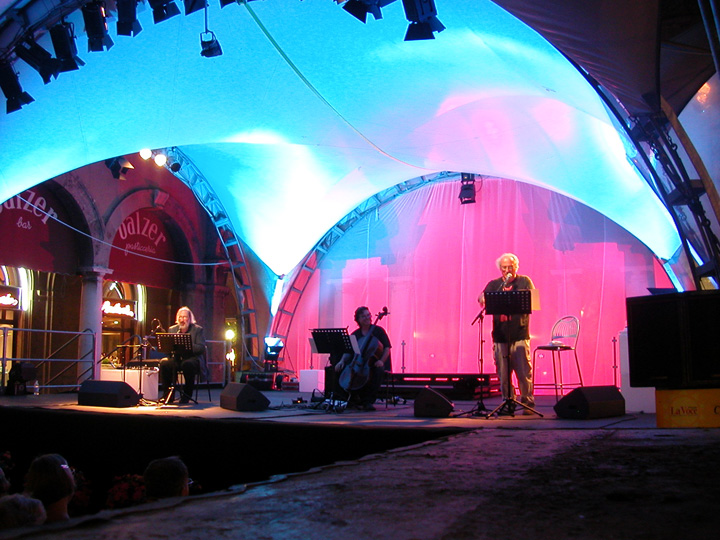Notti di Luce (Nights of Light) has been offering events at a high cultural level for eight years and – thanks also to the increasingly frequent air links with Orio al Serio airport – has made the City of Bergamo an international destination sought after by tourists rediscovering the pleasure of experiencing the city by night. This year Nights of Light has widened the circle of associations, institutions and businesses involved in the project: the organising staff, too, included highly experienced and dynamic professionals starting from Arch. Walter Barbero, who took charge of urban lighting, and Arch. Domenico Egizi, in charge of architectural interiors.
Nights of Light 2006 spread over two weeks, starting from the Feast Day of St. Alessandro, the Patron Saint of Bergamo. During the course of these two weeks light was used to pick out places and architecture in both the lower city and the upper, ancient one while, as is usual, the final evenings of the event were transformed into a festival of spectacles whose climax was the live appearance of singer Ron.
As is customary, Clay Paky sponsored the event and supplied all the lighting material for both the spectacles and the architectural spaces through the services of SG Lighting, which also looked after the installation.
LIGHTING THE SHOWS
Outstanding among the events hosted were the showing of the “Happy Prince”, from a short story by Oscar Wilde, “The Golden Guys” Gospel Concerto with Sarah Jane Morris, a tribute to actor Giorgio Strehler, the “Story of Onehand Jack and Other Strange Loves” show with Stefano Benni and top jazzman Gianluigi Trovesi, the show by Sergio Sgrilli directly from the Zelig Circus and the concert by Ron.
“This year we wanted to create a very close link between the production and the lights” said Artistic Director Claudio Angeleri“we wanted the light to do more than just light the stage and to become a veritable language of expression. The work of integrating the light and spectacle lasted almost a year, but we were truly very happy with the result: I see that this approach has aroused great interest and is about to be adopted for similar events in other cities”.
Gianbattista Scarpellini, SG Lighting manager, told us how they organised themselves for the event: “For the final evenings we had to provide two settings each day for the whole duration of Nights of Light. So a double team and a double set of lights were needed to ensure coverage of all the events in the programme. Our work was a true tour-de-force, because when one show finished we already had to prepare the setting for next day’s one. In cases like this it is important to be able to count on the reliability of the projectors used which, notwithstanding the continual movement from one set to another, never gave me any problems”.
The light system included various Clay Paky 1200W moving body units, as well as CP Color fixed units of different power (150W and 400W), particularly suitable for the backdrop of the shows and for the surrounding urban lighting.
LIGHTING THE ARCHITECTURE
In the centre of Bergamo, as in many other cities, there is a strong presence of light due to the numerous shop windows, signs, street lighting and traffic. Architect Barbero’s choice was to enhance and upgrade the historic architecture that, in everyday circumstances, runs the risk of being unnoticed. He therefore worked “by subtraction”, switching off some of the “disturbing” light sources and specifically lighting historical architectural sites and monuments. It was thus possible for all citizens to rediscover historical palazzos, corners and paths in their fullness.
Architect Barbero designed a lighted route along the Sentierone, namely the old main road of the city, which has abdicated its function for years in favour of the more modern and traffic-ridden Via Vittorio Emanuele. “Many people rediscovered the historic importance of the old Sentierone, returningto their roots a little” said Angeleri.
The design consisted of ten 300W light sources installed at a height of about 7 metres and equidistant from each other, to retain perfect visual perspective. Each of these light sources consisted of a Clay Paky V.I.P. with 300W discharge lamp and a good four metres of optic fibres connected to it. In its turn each group of optic fibres consisted of 200 threads that were left swinging in the void.
As part of the architectural upgrading project it was decided to light the Column of Via Sant’Alessandro, the only Roman remain in the city centre. The lighting provided a route of light leading to the base of the column and then continuing on the column itself. The effect achieved was as if the column was projecting its own luminous shadow, a visual stimulus and creative solution at the same time. The effect was obtained using 2 Clay Paky V.I.P. 300 units with their respective shapers, also supplied by Clay Paky as accessories.
The lighting also involved the Chamber of Commerce in Piazza Dante, the Church of San Bartolomeo and Palazzo Frizzoni. This involved fixed lighting in all cases, with the intention of enhancing these buildings through the use of a color specially chosen by Architect Barbero. The choice was intended to compromise between respect for the historic nature of the building and the creative interpretation of the event. Identification of the best colour was possible thanks to the Clay Paky CP Color 575 units, color changing projectors with IP65 protection level, which offer an infinite range of colors and a choice of lamps with different color temperatures.
Artistic Director Claudio Angeleri concluded: “Shrewd use of the lighting was fundamental in reaching our ends and the great versatility of the Clay Paky projectors allowed us to implement all our projects, even if they were very numerous and different from each other. We are confident that our ideas can give valid pointers how to make cities more pleasant to live in, more human and fit for man”.




















